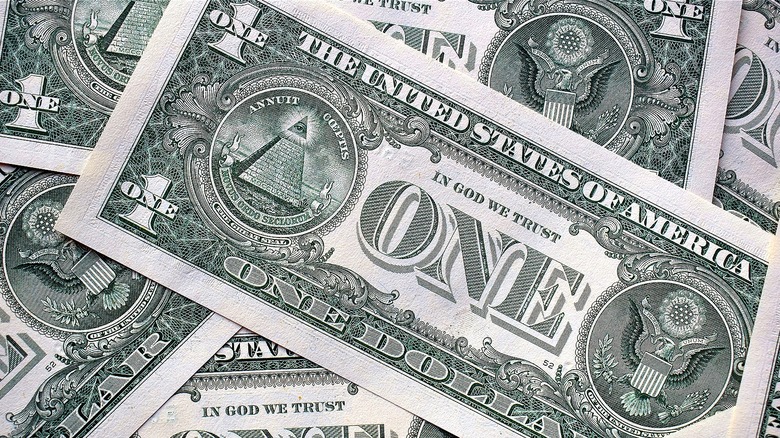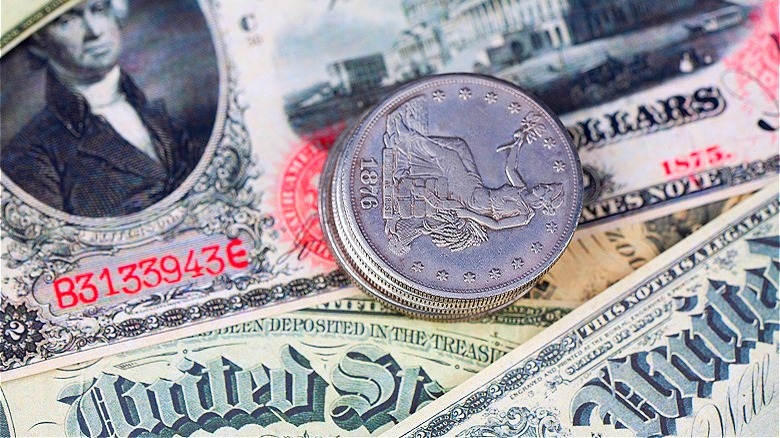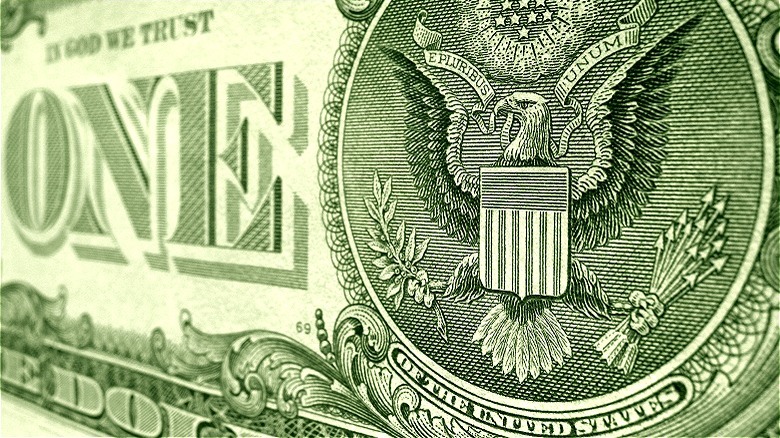What Do All The Symbols On The $1 Bill Actually Mean?
While you might not personally use cash much anymore (hello digital wallets, digital currency, and payment apps), chances are you're still familiar with what our paper bills look like. A familiar green with recognizable images of former important (for now, all male) Americans. Perhaps the most iconic of America's dollar bills is the $1, featuring George Washington front and center. However, did you know there are a myriad of symbols and cultural references also included in this bill? From ancient Egyptian imagery to Roman numerals to symbols of divinity, there's a lot to unpack on the $1 bill.
Perhaps the most notable symbolism found in the $1 bill is contained within the two large seals on the back, which comprise the Great Seal of the United States. With a pyramid in one and an eagle in the other, the back of the $1 bill represents many of early America's goals and ideals. The pyramid drew inspiration from Egyptian imagery (Benjamin Franklin and Thomas Jefferson actually wanted a pharaoh and never even considered a pyramid), but it also represents strength and duration. The eye at the top was meant to be a symbol of divine providence rooted in the ancient all-seeing symbol of divinity. The eagle, with its shield and stars, also holds symbolism in its talons. The eagle holds an olive branch representing peace as well as a sheaf of 13 arrows representing war. Throughout these symbols, as well as within imagery throughout the $1 bill, are regular references to the number 13, meant to represent the original colonies.
History of the bill
You might be surprised to learn that the very first $1 bank note for the United States didn't feature George Washington at all. First issued during the Civil War, the bill actually featured a portrait of Salmon P. Chase, the secretary of the treasury at the time. While today's $1 bills feature a Department of the Treasury seal consisting of balancing scales and stars representing the original 13 colonies, the seal during the Civil War was decidedly different. The seal featured spikes encircling the center seal imagery, and the Treasury specifically selected 34 spikes to represent the states in the Union. This was particularly important timing since 11 states ended up seceding from the union at the beginning of the Civil War; however, the Treasury viewed their secession as temporary and didn't change the seal.
It's worth mentioning that many of the symbols that appear on the $1 bill today were not part of the $1 bill for many years after its initial introduction. Most notably, the Great Seal didn't gain traction or appreciation until President Franklin Roosevelt took a keen interest in the symbolism of the seal and approved a new dollar bill design (featuring both elements of the seal) in 1935. Another element that was added later was the inclusion of "In God We Trust" on U.S. currency. Congress didn't pass a law making the phrase the country's national motto until 1956, leading to its first appearance on paper bills in 1957.
Who designed the Great Seal?
The $1 bill holds the majority of its symbolism within the seals on the back. This is where a special committee, created in 1776, comes into play. Before the Continental Congress was adjourned (on the very famous July 4, 1776), they created a committee that included John Adams, Thomas Jefferson, and Benjamin Franklin to create a seal that would represent the ideals of America. However, (much like deciding whose portrait should appear on bills) there were disagreements between the committee and Congress as to how complicated the seal should be. This meant that the design process took six years across three different committees to complete. The final 1782 proposal (that ultimately led to congressional approval) was the work of Charles Thomson, secretary of the Continental Congress, who combined concepts from all three of the committees. This became known as the Great Seal of the United States.
More than likely, you'll recognize this final seal for the $1 bill as "an American Eagle on the wing and rising," as described by Thomson himself. However, the eagle actually wasn't introduced as a design element until the third committee. Also important, and one of the most notable inclusions in the Great Seal, is the motto "e pluribus unum" — Latin for "out of many, one" — which was a direct inclusion from the original committee of Franklin, Jefferson, and Adams. The second committee's design for the eagle's shield, which contained 13 vertical bars representing the country's original colonies, as well as the star constellation (also 13) above the eagle, were also incorporated into the final seal.


